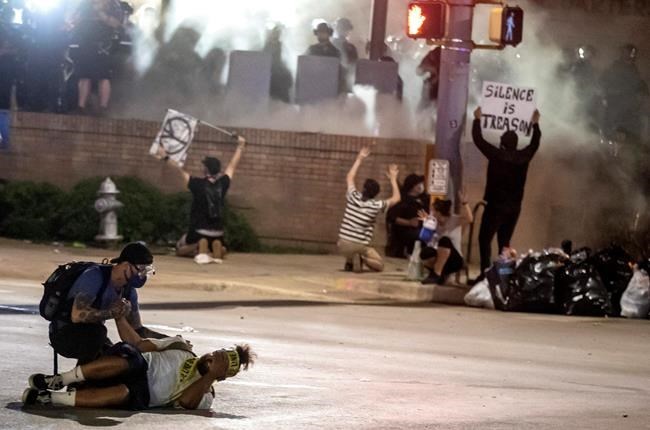
FILE - In this May 30, 2020 file photo, people help a protester after he was shot with a rubber bullet under Interstate 35 freeway in Austin Texas while protesting the death of George Floyd. A group of doctors in Austin is warning police not to use so-called “less lethal” munitions for crowd control after they treated people who were severely hurt during protests in May. In a letter published Friday, Aug. 14, in the New England Journal of Medicine, 12 doctors from the Dell Seton Medical Center at The University of Texas say Austin police who fired bean bag rounds caused injuries including bleeding on the brain and a skull fracture. (Ricardo B. Brazziell/Austin American-Statesman via AP, File)
Republished August 14, 2020 - 3:18 PM
Original Publication Date August 14, 2020 - 11:56 AM
AUSTIN, Texas - A group of doctors in Austin, Texas, warned Friday against police use of so-called “less lethal” munitions for crowd control after they treated people who were severely hurt during protests in May.
In a letter published in the New England Journal of Medicine, 12 doctors from the Dell Seton Medical Center at The University of Texas said Austin police who fired beanbag rounds caused injuries including bleeding on the brain and a skull fracture.
“I have been around the world and I have never seen beanbag injuries like this ever,” said Dr. Jayson Aydelotte, who helped author the letter. “I always thought they bruised your chest and that is it.”
Aydelotte, a trauma surgeon at Dell Seton Medical Center, said that based on his experiences in the military, beanbag bullet injuries resemble those caused by a regular bullet. He said all the doctors were surprised at the severity of the impact wounds among the patients who were hit.
“Although our report reflects the experience at only one centre during a short period and we cannot determine the frequency of injuries when these munitions are used, these findings highlight the fact that beanbag munitions can cause serious harm and are not appropriate for use in crowd control,” the letter said. ”In light of the ongoing nationwide protests, these observations are relevant to the broader medical community as well as to policymakers seeking to reduce rates of police-induced injuries and fatalities."
Austin’s police chief pledged in June to stop firing beanbag rounds into crowds, after a teenage protester was critically hurt when he was shot in the head with a beanbag.
There has been little research on the impact of less lethal munitions and what does exist points to minor blunt injury patterns, the doctors said in the letter. But some cases they witnessed in Austin resulted in a need for serious treatment including emergency intubation and prolonged stays in intensive care units.
Dr. Kristofor Olson said he was on duty at the Dell Seton emergency room when the patients who were hit by beanbags came in. He said he was shocked at the volume of people coming in with beanbag injuries both nights in late May.
Patients ranged in age from 16 to 54, the letter said, and five of those injured had head injuries. Two had facial fractures, and 12 had other injuries including contusions, cuts and other bone fractures. The doctors' letter includes images of CT scans to show brain and skull injuries and a photograph of a patient with a beanbag stuck in her face.
Olson and Dr. Laura Haselden were lead writers of the letter, which said of the 19 people treated at the UT hospital, eight were admitted to the hospital, seven underwent surgery and four retained fragments or entire beanbag bullets.
Protests broke out nationwide in late May following the death of George Floyd, who died after a Minneapolis police officer pressed his knee on Floyd's neck for nearly eight minutes, even after Floyd said he couldn't breathe.
The use of force to tamp down demonstrations against police brutality has caused outcry nationwide, most notably when federal agents clashed with protesters in Portland, Oregon, and law enforcement deployed tear gas and flash bangs to break up a peaceful gathering in Washington, D.C., before President Donald Trump walked to a church to be photographed holding a Bible.
___
Acacia Coronado is a corps member for the Associated Press/Report for America Statehouse News Initiative. Report for America is a non-profit national service program that places journalists in local newsrooms to report on undercovered issues.
News from © The Associated Press, 2020